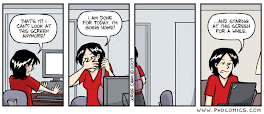Hyperopia degrees
- Low: 0 - (+2.00) D
- Medium: (+2.25)-(+5.00) D
- High: More than +5.00 D
 Usually, if hyperopia is low, hyperopic people do not have any symptom, and the time can go by until they show any. Besides, the younger the person is, the lesser the symptoms she will have, since her accommdation works perfectly and therefore, she can compensate the problem without any effort.
Usually, if hyperopia is low, hyperopic people do not have any symptom, and the time can go by until they show any. Besides, the younger the person is, the lesser the symptoms she will have, since her accommdation works perfectly and therefore, she can compensate the problem without any effort.Either medium hyperopic, or not so young people or in certain cases will show (without wearing the refraction) the following symptoms:
- Constant or intermittent blurred near vision.
- If hyperopia is medium/high, it also affects distant vision.
- Visual inconvenience when she performs close-up tasks.
- Headache, visual strain, ocular pain, burning, itching, tearing, red eyes… (due to incapacity of keeping the effort of accommodation that is demanded).
- In the case of low hyperopia that people have always been able to compensate without any problem (both as from a distance and as close up), as time goes by or in a special period with too many close-up tasks (at work or at school), they show inconvenience and discomfort and they do not know the reasons why they are caused. They have always seen well and have not had any previous visual problems; and they do not think, that this can be the cause of their problems. Before seeing blurred at near (while they can still keep the accommodation with effort), they usually show the symptoms above (headache, visual strain, itching, red eyes,...).
- In the case of children or young people, they usually have problems with the reading: line jumping, jumping letters, letters “seem to dance”, “they don’t stop!”… (presbyopic or old sight people also say these same words). These symptoms cause that they have aversion to reading.
- They as well perform facial contortions or frequent blinking while reading, that shows the effort that they are doing in their close-up tasks.
- Poor eye-hand coordination.
- In children (younger than 3 years old), if hyperopia is high, it can cause accommodative convergent strabismus (crossed-eye). This is because as they are young, they can perform much effort in order to see the image clear; but since accommodation and convergence are related (I will explain this better later), when the eyes perform too much accommodation, they also converge a lot, and one of eyes gets crossed. Consequently, this can also cause lazy eye or amblyopia on that eye.
- In the case of low hyperopic people who have always been able to compensate without any problem and they have always had a enviable sight in their youth, they inevitably undergo presbyopia. But unfortunately for the hyperopic, they suffer it before that the rest of the people, before they are 40 years old. These people will think that their arms are shorter each time, because they need put their reading text farther (but this refractive disorder deserves its own post later).
RELATED POST
Refractive disorders: Hyperopia , Hypermetropia or Farsightedness. (1) Vision and Accommodation
Refractive disorders: Hyperopia (2) Different features.
Refractive disorders: Hyperopia. (4) Solutions.
Refractive visual disorders. Some clarifications.
Some numbers...






1 comment:
Good brief and this mail helped me alot in my college assignement. Gratefulness you seeking your information.
Post a Comment